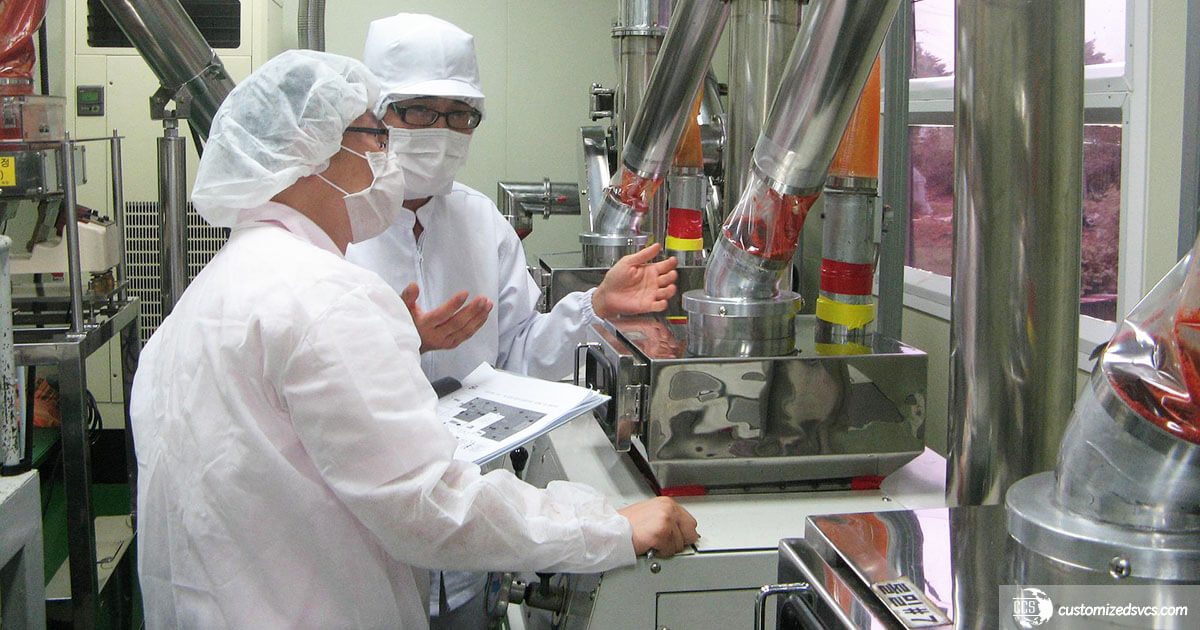
After the recent pandemic, it’s more important than ever to ensure you’re thoroughly cleaning your food processing facility. Consumers rely on food processing plants to maintain the utmost standards when it comes to cleaning and sanitizing.
Because food preparation, handling and processing areas can easily become contaminated, proper cleaning and sanitizing is crucial. Foodservice operators, beverage manufacturers, and food production companies often assume if a food contact surface is visibly clean, it’s also sanitary.
But this is not the case. Bacteria such as E. Coli and salmonella are resistant to detergents and soaps. Therefore, the threat of bacterial contamination has not been full addressed regardless of how persistently a surface is cleaned.
Sanitizing and Cleaning A Food Processing Facility
Cleaning and sanitizing are not the same but, rather, two different procedures. Cleaning helps increase the effective of sanitation efforts. For example, it removes soil, debris and dirt at a visible surface level. This organic matter can be a breeding ground for bacteria.
Therefore, cleaning a food processing facility needs to always be done first. After that, sanitizing is what actually reduces the number of bacteria to levels consider safe for human health.
Below are summarized steps for sanitizing and cleaning a food processing facility. Particularly, contact surfaces, food processing and handling areas where the possibility of contamination could exist. These steps also apply to foodservice establishments.
1. Remove Debris
Using a lint-free cloth, remove soil deposits off of food contact surfaces. Soils include proteins, salts, particles, lubricants, dirt and other residues. You can also use scrapers, brushes, dry floor mops, and vacuums to remove soil.
2. Rinse All Residues
When rinsing equipment, use warm (less than 120°) drinking water. Anything warmer could cause soil and particles to become adherent to a surface. Thus, preventing removal. Don’t use high-pressure hoses as they can cause recontamination issues. Additionally, high-pressure methods could also damage processing equipment.
An exception to this step is if the area or equipment being cleaned needs to stay dry. Exposing dry food products to moisture can lead to bacterial and mold growth. Consequently, dry food processors must apply interim dry-cleaning methods in-between any periodic wet cleaning. Instead, thoroughly wipe down the surface with a cleaning solution and lint-free towels. Also, the cleaning solution should be suitable for food contact surfaces. Then, use lint-free towels to dry all surfaces. Other solvents such as alcohol-based wipes can also be used as a rinse for dry areas.
3. Apply Detergent and Scrubbing
For this step, it’s essential to use chemical cleaners intended to remove protein and fat. Additionally, detergents should be properly mixed to ensure the appropriate concentration. To make cleaning efforts productive, manual scrubbing of surfaces is strongly recommended.
When cleaning a food processing facility, the equipment should be disassembled. This allows all stationary parts to be optimally cleaned and sanitized.
In general, this step does not apply to dry processing environments. Excluding the disassembling of stationary parts.
4. Rinse Thoroughly
Before proceeding to the sanitizing stage, do a final rinse with drinking water. Doing so ensures that the detergent and any residue is completely removed. This step is very important because detergents are alkaline and most sanitizers are acidic. Without a thorough rinse, the sanitizer could be neutralized by any remaining detergent on the equipment surface. The water can also be warmer than what was recommended for the first rinse.
As mentioned before, a rinse is not recommended in dry areas. The exception is when equipment parts are being cleaned in a separate area. Or, unique circumstances require minimal amount of water to remove soils. In the latter case, surfaces must be dry before applying a disinfectant or sanitizer.
5. Take a Closer Look
Inspect and, if necessary, spot clean any areas where there are still visible signs of residue or detergent.
Pay special attention to hard-to-reach places. If you are foodservice operators, be aware of food zones that are not cleanable by hand. For example, ice machines, and ice cream and beverage dispensers. In general, manufacturers provide cleaning instructions for these areas.
6. Disinfect or Sanitize
To help safely reduce bacterial load, apply an effective sanitizing or disinfecting chemical. Ensure the solution is suitable for food and beverage environments. Before going further, an explanation of the difference between sanitizing and disinfecting is likely needed.
While similar processes, there is a difference between sanitizing and disinfecting. They both kill bacterial and other microorganisms. Disinfectants kill considerably more microorganisms but generally at a slower rate. They also contain stronger chemicals. However, this does not necessarily mean a disinfectant is dangerous to use in a food processing facility or restaurant.
7. Dry
The final step in sanitizing and cleaning a food processing facility is drying. When using a rinse-off disinfectant or sanitizer, the product must be completely removed with drinking water. Air drying is the ideal way to dry surfaces because a wipe-down could lead to re-contamination. For areas that must be kept dry or cannot facilitate air drying, a leave-on sanitizer or disinfectant is recommended.
Cleaning and sanitizing a processing facility is no easy feat. For this reason, Customized Custodial Services offer facility cleaning tailored to your needs. Contact us today for an estimate and walkthrough.
You may also enjoy reading: Why Use Professional Janitorial Services For Your Business?
